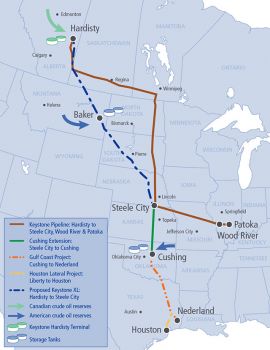The Gift of South Dakota
Subscriptions to South Dakota Magazine make great gifts!
Subscribe today — 1 year (6 issues) is just $29!
It's Time for Keystone
Feb 12, 2014
It says a lot about the environmental movement that the opposition to the Keystone XL pipeline is judged a success whether or not it actually stops the pipeline from being built. The New York Times has this:
Although some critics say the environmental movement has made a strategic error by focusing so much energy on the pipeline, no one disputes that the issue has helped a new breed of environmental organizations build a mostly young army eager to donate money and time. The seven-year-old email list of 350.org, an organization that focuses on climate change, has more than doubled to 530,000 people since the group began fighting the pipeline in August 2011. In addition, about 76,000 people have signed a “pledge of resistance” sponsored by seven liberal advocacy groups in which they promise to risk arrest in civil disobedience if a State Department analysis, expected this year, points toward approval of the pipeline.
The Keystone XL project has also raised the profile of a diverse generation of environmental leaders, like the activist Bill McKibben, a former writer for The New Yorker and founder of 350.org, and the billionaire venture capitalist Thomas F. Steyer, who is estimated to have contributed at least $1 million to the movement and has starred in four 90-second ads opposing the pipeline.
So all the delays in the approval process, all the folks standing around with Stop Keystone signs, all the passionate bloggers, appalled pundits, and concern Congresspersons served this purpose: increasing the email list of 350.org and raising the profile of an activist and a billionaire.
It has accomplished little else beyond delaying the inevitable. The most recent State Department review of the environmental impact of Keystone XL confirmed what the last recent State Department review concluded: building and operating the pipeline won’t make any appreciable difference.
The reason is obvious. Oil is energy and energy is valuable. If Canadian tar sands oil is worth more than it costs to separate the tar from the sands, then the oil will flow. If it doesn’t flow into a pipeline that runs toward refineries on the Gulf Coast (entering South Dakota in Harding County and exiting southeast of Winner), it will flow somewhere else. A pipeline toward Canada’s west coast might carry it. Otherwise it will be loaded on trains. According to the Washington Post, 180,000 barrels of Canadian Crude are moving on trains every day.
The trains don’t run on wheat grass extract, they run on fossil fuels. And they occasionally leave their tracks. In July 2013, a runaway train derailed in the town of Lac-Mégantic, Quebec. The resulting explosion killed 47 people, destroyed 30 buildings, and necessitated the evacuation of the entire town. Pipelines may occasionally leak but they do not run off on their own in the middle of the night.
To see that building Keystone XL makes sense, all you have to do is consider the arguments against it. The New York Times complains that the pipeline will not create a lot of long-term jobs. That may be true if one considers only the people directly employed in servicing and operating the pipeline. However, that oil will flow to American refineries, which employ a lot of folks. Meanwhile it will create a lot of jobs while it is being built, and right now is when a lot of people need jobs. Others have argued that the refined oil will be sold abroad, perhaps even (horrors!) to China. Okay. Refining crude resources and then selling them is one of the chief sources of national wealth. The U.S. will not be better off, economically, if the oil doesn’t cross our borders.
The Keystone project has been under review for five years, longer than any similar project. It has passed every review. Even the Washington Post recognizes that it is time to get on with it. Environmentalists are certainly right that we ought to be concerned about the natural environment and that we ought to take climate change seriously. It is not enough to be concerned, however. What we need are solutions that take reality into account. The reality is that our civilization will depend on fossil fuels for some time to come. When the environmental movement measures success by the increase in their email list instead of policies that actually benefit the environment, it is squandering its resources.
Editor's Note: Ken Blanchard is our political columnist from the right. For a left-wing perspective on politics, please look for columns by Cory Heidelberger every other Wednesday on this site.
Dr. Ken Blanchard is a professor of Political Science at Northern State University and writes for the Aberdeen American News and the blog South Dakota Politics.











Comments
Just pondering what the resistance might be if, say, we could move weed or Pinot Noir via pipeline.